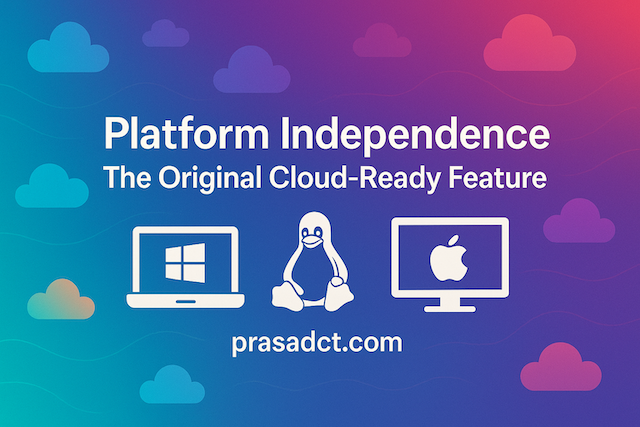In today’s rapidly evolving tech landscape, developers and organizations face critical decisions about which programming languages best suit their cloud applications. As someone who’s been working with Java for years, I’ve witnessed firsthand how this battle tested language has not only survived but thrived in the cloud era. Let’s explore why Java remains extremely relevant for cloud computing in 2025 and beyond.
Platform Independence – The Original Cloud-Ready Feature
Long before “cloud-native” became a buzzword, Java pioneered the “Write Once, Run Anywhere” philosophy. This platform independence wasn’t just a nice marketing slogan – it laid the groundwork for what we now consider essential for cloud deployments.

Java’s platform independence allows applications to run on any system with a Java Virtual Machine (JVM), making it ideal for cloud environments where applications need to be deployed across diverse systems. When you’re working with multiple cloud providers or considering a multi-cloud strategy, this capability becomes invaluable.
I’ve personally migrated Java applications between AWS, Azure, and on-premises environments with minimal code changes. The JVM acts as an abstraction layer that shields your code from the underlying infrastructure differences, allowing you to focus on business logic rather than platform-specific quirks.
Scalability for Modern Cloud Demands
Cloud applications need to handle variable loads and scale dynamically. Java excels here too.
Java is designed to handle large scale distributed systems, supporting multithreading and distributed computing. This makes it well suited for cloud applications that need to scale dynamically to manage high volumes of users and data, ensuring performance under varying loads.
The language’s mature concurrency model allows developers to create applications that effectively utilize multi-core processors and distributed architectures. Java’s built-in support for concurrency primitives, combined with frameworks like Akka, makes it easier to build systems that can scale horizontally across cloud instances.
Enterprise-Ready Security
Security concerns only intensify in cloud environments. Java provides robust security features out of the box.
Java offers robust security features, such as bytecode verification and access control, which are critical for cloud applications handling sensitive data. These built-in security measures help protect applications in the distributed and open nature of cloud environments.
The JVM’s security manager, combined with Java’s strong typing system, provides multiple layers of protection against common vulnerabilities. Additionally, the extensive security libraries and frameworks available for Java make implementing encryption, authentication, and authorization relatively straightforward.
Rich Ecosystem and Tooling
One of Java’s greatest strengths is its vast ecosystem of libraries, frameworks, and tools.
Java boasts a vast ecosystem, including frameworks like Spring Boot and Quarkus, and tools like Hibernate and Apache Kafka. This rich set of resources simplifies the development of feature-rich cloud applications, supporting everything from microservices to serverless computing.
As a developer, I’ve found this ecosystem invaluable. Spring Boot drastically reduces the boilerplate code needed to start a new project, while Quarkus optimizes Java for containerized environments with faster startup times and lower memory consumption.
Cost Effectiveness in Cloud Deployments
Budget considerations are paramount when moving to the cloud, and Java offers significant cost advantages.
Java is affordable and open-source, which means businesses save on licensing and tooling costs. Its efficient runtime performance also reduces cloud operational expenses, especially in serverless setups with features like Ahead-of-Time (AOT) compilation.
The initial development cost might be higher compared to some scripting languages, but Java’s performance efficiency often results in lower infrastructure costs over time. With modern optimizations like AOT compilation in GraalVM, Java applications can start faster and consume less memory – directly translating to lower cloud bills.
Business Benefits Beyond Technical Advantages
From a business perspective, Java offers several strategic advantages.
Java’s “write once, run anywhere” capability, thanks to the Java Virtual Machine (JVM), allows applications to work across different cloud platforms like AWS, Microsoft Azure, and Google Cloud Platform. This flexibility is great for businesses with diverse systems [https://digitalcloud.training/the-best-programming-languages-for-cloud-computing/].
The widespread adoption of Java also means a large talent pool is available, reducing hiring challenges and costs associated with finding specialized developers [https://www.nearsure.com/blog/what-is-the-future-of-java-and-cloud-computing].
Integration With Major Cloud Providers
All major cloud providers offer extensive support for Java applications.
Java integrates well with major cloud providers like AWS, Google Cloud Platform (GCP), and Microsoft Azure. This compatibility enhances its suitability for developing and deploying cloud-based applications, making it easier to leverage cloud services.
AWS Lambda, Azure Functions, and Google Cloud Functions all support Java, allowing developers to build serverless applications without learning a new language. Additionally, cloud-native frameworks like Spring Cloud make it easier to implement cloud patterns such as service discovery, configuration management, and circuit breakers.
Recent Performance Improvements for Cloud Environments
Recent Java releases have significantly improved its cloud performance.
Recent advancements in Java, particularly with frameworks like Quarkus, have optimized it for cloud-native environments. Quarkus enables applications to start in less than 1 second compared to 3 minutes for Spring Boot, and uses 57% less memory per call [https://www.redhat.com/en/resources/java-in-cloud-computing-detail].
These optimizations directly address previous criticisms about Java’s resource consumption and startup times, making it more suitable for containerized and serverless environments where rapid scaling is important.
Real-World Adoption
Many major companies rely on Java for their cloud infrastructure.
Java’s effectiveness is demonstrated by its adoption by major companies. Netflix’s use of Java for microservices on AWS showcases its scalability in real-world scenarios.
Other examples include financial institutions like Bankdata, which achieved 57% less memory usage, and Lufthansa Technik, which achieved 3x denser deployments with Java applications on Red Hat OpenShift.
Comparing Java with Other Cloud Languages
While Java has many strengths, it’s important to acknowledge the competition.
There are debates, particularly around Java’s performance in serverless environments. Some sources suggest that Java may face challenges with startup times and deployment size in serverless contexts, where Python is often preferred for its lightweight nature.
However, with the advent of GraalVM and Quarkus, these concerns are being addressed. The choice ultimately depends on your specific use case, team expertise, and project requirements.
Conclusion
Java’s enduring relevance in the cloud era stems from its combination of platform independence, scalability, security, and a rich ecosystem. Its “write once, run anywhere” philosophy aligns perfectly with cloud computing’s promise of flexibility and scalability.
While newer languages might grab headlines, Java continues to evolve and adapt to cloud requirements. Recent improvements in startup time and memory consumption have made it even more suitable for containerized and serverless environments.
For businesses with existing Java investments, moving to the cloud doesn’t mean abandoning your Java codebase. Instead, embrace modern Java frameworks and tools designed for cloud-native development to get the best of both worlds.
The future of Java in the cloud looks bright, and as organizations continue their cloud journey, Java will likely remain a reliable, performant, and cost-effective choice for cloud applications.
What’s your experience with Java in cloud environments? Have you used frameworks like Spring Boot or Quarkus for cloud deployments? Share your thoughts in the comments below.
References
- Java and the Cloud: A Match Made in Heaven
- Java in the Era of Cloud Computing
- Moving Java Workloads to Cloud Environments with Red Hat
- Best Programming Languages for Cloud Computing
- The Best Programming Languages for Cloud Computing
- What is the Future of Java and Cloud Computing
- Java or Python for Cloud Computing – Reddit Discussion
- 5 Programming Languages For Every Cloud Engineer to Learn
